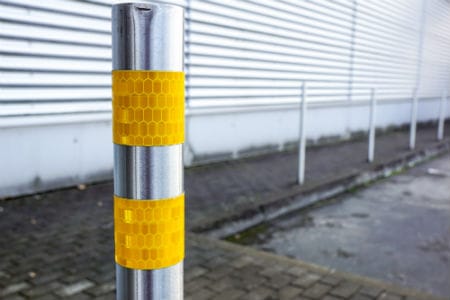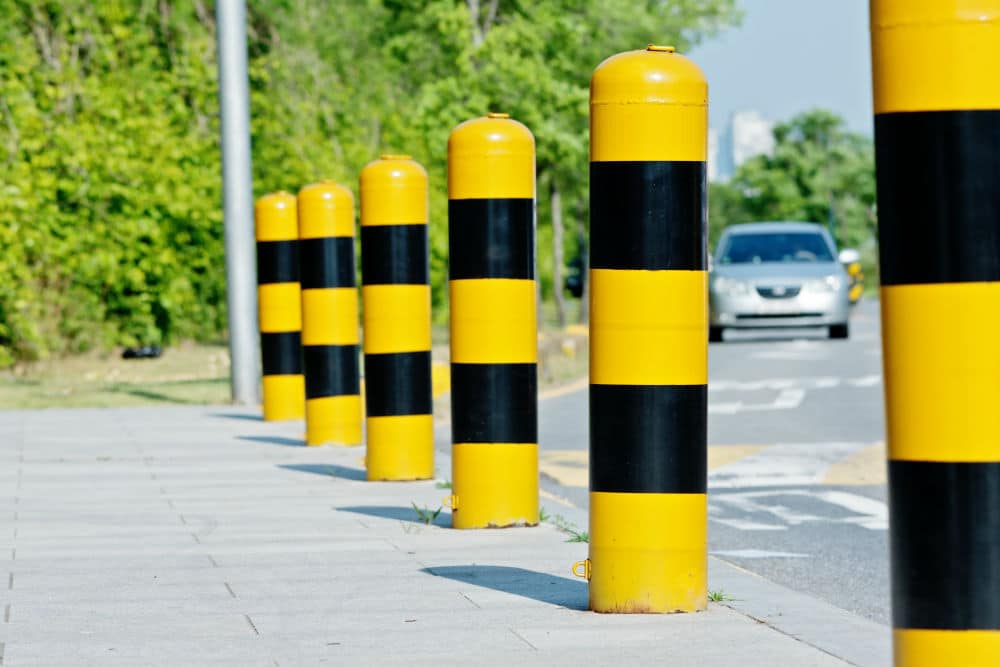If you’ve ever taken a stroll through the downtown area of a town or city, you may have noticed those distinctive steel posts that stand outside some storefronts. These posts are known as “bollards” in the construction industry; modern versions are short, sturdy, and filled with concrete with an outer steel shell. While commonly overlooked, steel bollards serve a variety of purposes.
The history of bollards dates back thousands of years. The Roman Empire used them to tether horses and livestock outside public buildings, and they were also used as milestones along roads (as they are often still used today). In the 17th and 18th centuries, old cannons were utilized as bollards, using a slightly-too-large cannonball to cap off the open barrel and protect the interior from dirt and water. This design became a standard that is stylistically reflected in many modern-day bollards.
There are over a dozen practical applications for bollards, several of which have endured for hundreds of years or more. The more common uses for steel bollards are as follows.
To Direct the Flow of Traffic
One of the most common uses of bollards–if not the most common use today–is to safely direct traffic in an organized manner. While the majority of public roads today use curbs to separate street traffic from pedestrians, in some instances walkways may be flush with the road, which often creates a safety hazard. Steel bollards prevent wayward vehicles from straying off the road into pedestrian territory when no other visible barrier is present.
Because they are meant to direct traffic and not as a security measure, these types of bollards are often made to be flexible, minimizing damage to both the bollard and any vehicle that strikes it. However, these bollards are still meant to stop moving vehicles, so a balance between flexibility and rigidity must be met to ensure that the bollard does its job adequately.
As a Safety Precaution
More often than not, steel bollards aren’t exactly used to direct traffic as much as halt it completely. In this way, they act as protective barriers, being placed around parks, public squares, and playgrounds to prevent out-of-control vehicles from careening through and potentially causing property destruction, injury, or death.

In addition, steel bollards are commonly used in front of banks, municipal buildings, storefronts, and other areas that are at higher risk of a security breach or destruction via high-speed vehicles. These bollards also protect against unintended accidents which can cause damage to property and valuables inside.
The strongest security bollards used today are sometimes referred to as “assault resistant” bollards, and are built to withstand multiple vehicle collisions. As thieves often rely on ramming their vehicles into buildings in a “smash and grab” fashion, these bollards can be lifesavers for high-value businesses. Bollard installations of this caliber often require guidance from a concrete contractor, to ensure proper substrate and installation so as to maximize impact resistance.
For Bicycle Parking
One of the more common historical uses of bollards was to provide a place to tie off boats when they were docking. While this is still in practice today, most parking bollards are used for street purposes, especially for bicycle parking. Some of these bollards have arms that extend out to allow a bike lock to loop around, and others have holes directly placed through the beam to allow for chains and u-locks.
Bicycle bollards are a great way to get multiple uses out of a steel bollard; not only do they provide a measure of security and protection, but they also provide a place for cyclists to secure their bikes, potentially increasing the appeal and traffic of establishments such as restaurants and stores.
For Aesthetics and Decoration
While most bollard installations serve a practical purpose, they are sometimes used solely for decoration. Bollards can be installed with a variety of designs, colors, and even lighting to accent surrounding architecture and landscapes. In addition, lighted bollards help guide pedestrians along in the dark.
Even security bollards can be spruced up to look less drab; steel bollards are often decorated during the holidays to add visual appeal.
Bollards come in all shapes, sizes, and materials, and certainly aren’t limited to steel. Cast iron, aluminum, polyurethane, plastic, and wood can all be used in bollards. However, the most structurally sound and impact resistant bollards are made with high-grade steel exteriors and a concrete interior.


